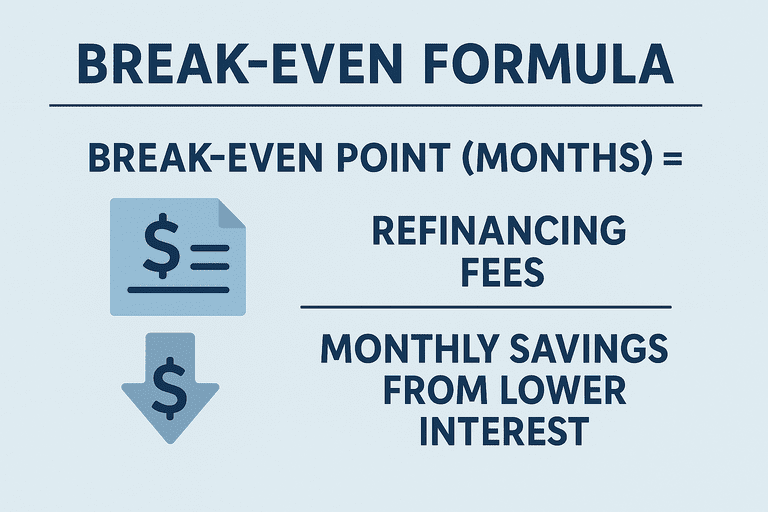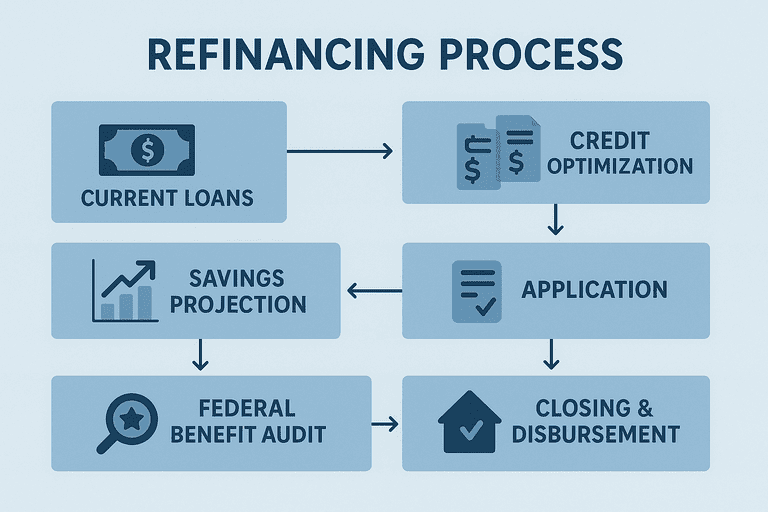The Strategic Value of Big Banks in Student Loan Refinancing
Student loan debt remains a crushing financial burden for over 43 million Americans, with total debt exceeding $1.7 trillion. For borrowers seeking stability and integrated financial services, big banks offer compelling refinancing solutions that combine competitive rates with institutional reliability. Unlike fintech startups or specialized lenders, established banking institutions provide branch access, relationship-based discounts, and streamlined banking integration.
However, navigating this complex landscape requires understanding nuanced trade-offs: federal loan protections surrendered versus potential interest savings, variable versus fixed rates, and the long-term impact of term lengths. Drawing on 15 years of financial blogging expertise, this definitive guide analyzes every facet of big bank student loan refinancing, arming you with data-driven strategies to optimize your debt repayment journey.
Section 1: Why Consider Big Banks for Student Loan Refinancing?
1.1 The Institutional Advantage
Big banks bring formidable financial infrastructure to student loan refinancing, translating to operational stability and extensive customer service networks. When you refinance with institutions like Citizens Bank or PNC, you’re accessing lenders with multi-billion-dollar balance sheets capable of absorbing economic volatility—a critical factor during recessionary periods. This contrasts sharply with fintech lenders whose funding often relies on capital markets. During the 2023 banking crisis, several online lenders suspended refinancing options, while major banks maintained consistent offerings due to diversified funding sources like consumer deposits and commercial banking operations.
Beyond financial stability, big banks offer integrated relationship benefits. For example, Citizens Bank provides a 0.50% autopay discount when payments come from a Citizens checking/savings account—double the industry-standard 0.25% . Similarly, PNC Bank offers preferred rates for existing wealth management clients. These synergies enable borrowers to maximize savings through consolidated financial relationships—something niche lenders cannot replicate.
1.2 When Big Banks Outperform Online Lenders
Statistical analysis reveals big banks consistently win on pricing for high-balance refinances (>$150k). According to 2025 refinancing data, Citizens Bank offers loan ceilings up to $750,000 for professional degrees—surpassing even specialized medical lenders like Laurel Road . This capacity stems from risk assessment models that evaluate earning potential holistically rather than relying solely on credit scores. For surgeons, attorneys, or MBA holders with high debt-to-income ratios early in their careers, this approach yields approvals where algorithms reject applicants.
Customer service accessibility represents another decisive edge. PenFed Credit Union—while technically a credit union—exemplifies the branch-based advantage with over 50 physical locations for in-person consultations . Contrast this with market darling Earnest, which lacks phone support entirely. When restructuring six-figure debt, many borrowers value face-to-face guidance unavailable from app-based lenders.
Section 2: Top 5 Big Banks for Student Loan Refinancing in 2025
2.1 Citizens Bank: Best for Relationship Discounts
Rate Profile & Eligibility
- Fixed APRs: 5.90%–11.09% | Variable APRs: 6.14%–12.05%
- Minimum Credit Score: 700+ (unofficial) | Minimum Income: $24,000
- Maximum Loan: $750,000 | Terms: 5, 10, 15, 20 years
Strategic Analysis
Citizens dominates our rankings through unparalleled discount stacking. Existing customers receive:
- 0.50% autopay discount (vs. standard 0.25%)
- 0.25% loyalty discount with qualifying deposit accounts
- Relationship pricing on bundled products like mortgages
This creates effective APRs as low as 5.15% for premier clients—beating most competitors. Unique among big banks, Citizens permits non-graduate refinancing if borrowers made 24 consecutive payments pre-refinance . However, geographic limitations apply: Banking services are unavailable in 12 states, restricting discount access.
Ideal Borrower Profile: High-balance professionals (doctors/lawyers) in Citizens’ Northeast/Midwest footprint seeking integrated banking.
Table: Citizens Bank Refinancing Tiers
| Degree Type | Max Loan Amount | Special Eligibility Notes |
|---|---|---|
| Undergraduate | $175,000 | 0.50% autopay discount only |
| Graduate | $200,000 | Loyalty discounts apply |
| Medical/Law | $750,000 | Requires proof of degree completion |
2.2 PNC Bank: Best for Co-Signer Flexibility
Rate Profile & Eligibility
- Fixed APRs: 5.79%–12.99% | Variable APRs: 7.69%–15.34%
- Minimum Credit Score: Not Disclosed | Minimum Loan: $10,000
- Terms: 5, 10, 15, 20 years | Co-signer Release: After 48 payments
Strategic Analysis
PNC’s standout feature is the industry’s fastest co-signer release at 48 months—compared to SoFi’s non-existent release or Earnest’s 12-month requirement . This positions PNC as the premier choice for borrowers needing temporary credit support. Additionally, PNC accepts non-traditional academic profiles: Associate degree holders and non-graduates qualify with 24 months of repayment history.
However, PNC’s degree-based loan caps create limitations:
- Associate degrees: Max $75,000
- No degree: Max $25,000
- Graduate degrees: Max $200,000
These ceilings exclude many dental/pharmacy graduates with $300k+ debts. Geographic restrictions also apply—maximum loans vary by branch location.
Ideal Borrower Profile: Borrowers with associate degrees or incomplete education needing co-signer partnerships.
2.3 PenFed Credit Union: Best for Flexible Repayment Terms
Rate Profile & Eligibility
- Fixed APRs: 4.49%–6.68% | Variable APRs: N/A
- Minimum Credit Score: Not Disclosed | Minimum Income: Not Disclosed
- Terms: 5, 8, 12, 15 years | Membership: $5 savings deposit
Strategic Analysis
PenFed disrupts traditional term structures with 8- and 12-year options—slashing interest costs versus standard 10-year terms. For a $100k loan at 6%:
- 10-year term: Total interest = $33,256
- 8-year term: Total interest = $26,512 (20.3% savings)
This granular term flexibility is unmatched among big banks. PenFed also offers military-specific benefits including 0.25% APR reductions for active duty personnel. However, exclusivity applies: Only federal/private education loans qualify—Parent PLUS loans are ineligible.
Ideal Borrower Profile: Veterans and borrowers seeking accelerated repayment between 5–15 years.
2.4 SoFi: Best Big Bank Alternative (Fintech Hybrid)
Rate Profile & Eligibility
- Fixed APRs: 4.49%–9.99% | Variable APRs: 5.99%–9.99%
- Minimum Credit Score: 650 | Minimum Loan: $5,000
- Terms: 5, 7, 10, 15, 20 years | Co-signer Release: Not available
Strategic Analysis
SoFi transcends fintech categorization through its national bank charter (acquired 2022), blending digital agility with regulatory stability. Its unlimited refinancing cap makes it ideal for MD/JD/MBA graduates with $500k+ balances . Member perks redefine value:
- Career coaching: Resume/LinkedIn reviews
- Unemployment protection: 3-month forbearance
- Wealth management: Free financial planning
However, SoFi’s degree mandate excludes non-graduates—a significant gap versus Citizens/PNC. Its variable rates also carry uncapped ceilings (max 13.95%), creating risk in rising-rate environments.
Ideal Borrower Profile: High-earning graduates valuing holistic financial services.
2.5 Honorable Mentions: Niche Players
- Splash Financial: Marketplace connecting borrowers to regional banks; $500 bonus for $100k+ refinances
- RISLA: Nonprofit offering income-based repayment (15% of income) unavailable elsewhere
- Laurel Road: Medical residency program ($100/month payments during training)
Section 3: Big Banks vs. Other Refinancing Lenders: A Data-Driven Comparison
3.1 Interest Rate Benchmarking
Table: 2025 Average Refinancing APRs by Lender Type
| Lender Category | Avg Fixed APR | Avg Variable APR | Max Loan Amount |
|---|---|---|---|
| Big Banks (Citizens/PNC) | 6.50% | 7.25% | $750,000 |
| Credit Unions (PenFed) | 5.60% | N/A | $300,000 |
| Fintech (SoFi/Earnest) | 5.20% | 6.10% | No limit |
| State Agencies (RISLA) | 6.15% | N/A | $250,000 |
Data reveals credit unions lead on fixed rates, while fintech dominates variable pricing. Big banks occupy the mid-to-upper tier but compensate with higher loan ceilings.
3.2 Eligibility & Feature Comparison
- Co-signer Acceptance: Big banks > Fintech > Credit Unions
- Non-Graduate Approvals: Citizens/PNC > Splash > SoFi (not permitted)
- Forbearance Length: RISLA (24 months) > Advantage (24 months) > Big banks (12 months)
Federal Loan Refinancing Warning: All private refinancing—including big banks—terminates access to PSLF, income-driven repayment, and future forgiveness programs .
Section 4: Strategic Refinancing: When to Choose Big Banks
4.1 Scenario Analysis: Matching Borrowers to Lenders
- Case 1: The Surgeon ($550k Debt)
Optimal Choice: Citizens Bank
Rationale: Only lender exceeding $500k cap; relationship discounts lower effective APR to 5.15% - Case 2: The College Dropout ($42k Debt)
Optimal Choice: PNC Bank
Rationale: Accepts non-graduates; 20-year term reduces payments by $178/month - Case 3: The Veteran Engineer ($125k Debt)
Optimal Choice: PenFed
Rationale: Military discounts; 8-year term aligns with promotion timeline
4.2 The Refinancing Calculus: Savings vs. Risk
Run break-even analyses before refinancing federal loans:

Example:
- Refinancing Fee: $0 (typical for big banks)
- Current Payment: $1,200/month @ 7.8%
- New Payment: $980/month @ 5.9%
- Monthly Savings: $220
- Break-Even: $0 / $220 = Immediate savings
However, forfeiting income-driven repayment safety nets creates risk. Reserve refinancing for borrowers with:
- Stable employment: >2 years in industry
- Emergency fund: 6+ months of expenses
- Private loans: No federal protections to lose
Section 5: The Step-by-Step Refinancing Roadmap
5.1 Pre-Application Optimization (90 Days Out)
- Credit Report Surgery: Dispute inaccuracies; target FICO >780 for best rates
- Debt-to-Income (DTI) Engineering:
- Pay down credit cards below 30% utilization
- Defer non-essential installment loans
- Document Arsenal:
- 2+ years tax returns
- 30 days of pay stubs
- Loan verification statements
5.2 Application & Negotiation Tactics
- Leverage Pre-Approvals: Use competing offers to negotiate better terms
- Timing Matters: Apply mid-month; underwriting departments face quota pressures
- Co-signer Strategy: Position release timelines as a negotiation point
Infographic: Refinancing Process Flow

5.3 Post-Refinancing Best Practices
- Autopay Enforcement: Never forfeit 0.25–0.50% discounts
- Annual Rate Audits: Re-refinance if rates drop >1.5%
- Extra Payment Protocol: Apply windfalls to principal; specify “principal-only”
Section 6: The Future of Big Bank Refinancing: 2025–2030 Trends
- AI Underwriting Expansion: JPMorgan Chase pilots earnings trajectory models predicting future income
- Student Loan Securitization: Bank of America developing refinanced loan ABS products to lower capital costs
- Forgiveness Partnerships: Wells Fargo exploring employer-linked programs where companies sponsor refinancing
- Rate Projections: With Fed cuts expected, 2026 rates may drop 0.75–1.25 percentage points
Conclusion: Banking on Your Future
Big banks deliver institutional heft and relationship perks unmatched in student loan refinancing—but only for the right borrower. Citizens Bank and PNC dominate for high-balance professionals and non-traditional graduates, respectively, while PenFed offers unparalleled term flexibility. Yet as fintech lenders erode pricing advantages, the big bank differentiator becomes integrated financial ecosystems—discounts across banking products, in-person support, and co-signer flexibility.
Final Strategic Imperatives:
- Audit Federal Benefits: Use StudentAid.gov’s forgiveness calculator before refinancing
- Play the Field: Secure 3+ pre-approvals to negotiate better terms
- Model the Break-Even: Include lost forgiveness value in savings calculations
In an era of economic uncertainty, refinancing demands more than rate shopping—it requires strategic alignment of debt management with lifelong financial goals. By leveraging big banks’ unique strengths while mitigating their limitations, you can transform student debt from a burden into a launchpad.
Explore Your Options:
Data sources: CNBC Select, Forbes, Bankrate, NerdWallet, Business Insider (2025 reports).

